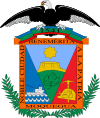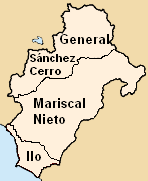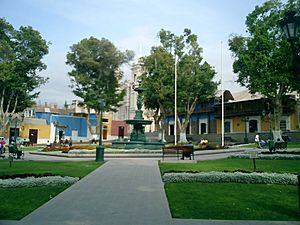Department of Moquegua facts for kids
Quick facts for kids
Department of Moquegua
|
|||
|---|---|---|---|
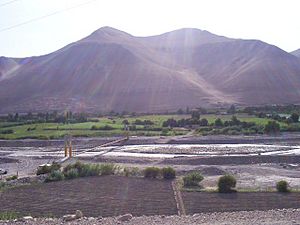
Moquegua valley
|
|||
|
|||
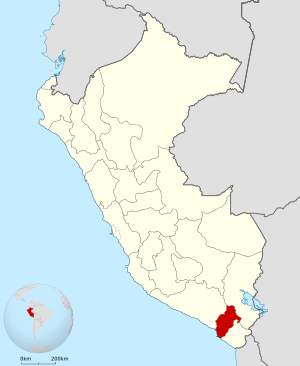
Location of the Department of Moquegua in Peru
|
|||
| Country | Peru | ||
| Subdivisions | 3 provinces and 20 districts | ||
| Largest city | Moquegua | ||
| Capital | Moquegua | ||
| Area | |||
| • Total | 15,733.97 km2 (6,074.92 sq mi) | ||
| Highest elevation | 3,756 m (12,323 ft) | ||
| Lowest elevation | 0 m (0 ft) | ||
| Population
(2017)
|
|||
| • Total | 174,863 | ||
| • Density | 11.11372/km2 (28.78441/sq mi) | ||
| UBIGEO |
18
|
||
| Dialing code | 053 | ||
| ISO 3166 code | PE-MOQ | ||
| Principal resources | Copper, olives and avocado. | ||
| Poverty rate | 29.6% | ||
| Percentage of Peru's GDP | 1.43% | ||
| Website | www.regionmoquegua.gob.pe | ||
Moquegua (Spanish pronunciation: [moˈkeɣwa]) is a department, or region, in southern Peru. It stretches from the coast all the way up to the high mountains. Its capital city is also called Moquegua. This city is important in Peru because of its strong economy and good education system.
Contents
Exploring Moquegua's Geography
Moquegua's geography is very special because of its volcanoes and unique land shapes. The region is shaped by the Tambo River, which is a fast-flowing river that creates deep valleys.
Valleys and Oases
The Tambo River valley has three main parts. The first part, in the northwest, is called Puquina-La Capilla. These areas are like green spots, or oases, surrounded by rocks. Here, people grow high-quality alfalfa and fruits, especially grapes. This is possible thanks to the good climate and rich soil.
The second part is the Omate valley. This is one of the most populated and fertile areas in the department. Close by is the Ubinas Volcano, which is the most active volcano in Peru! Even though the highlands can be dry, the hillsides here are very fertile.
The third part is in the southern area of the Tambo River, where the town of Carumas is located. Carumas, along with Puquina and Omate, are key towns in this region.
The Moquegua River
The Moquegua River is shorter. It's formed by smaller rivers like the Torata, Huaracane, and Tumilaca. After flowing through the capital city, it carves a deep canyon called the Osmare.
Moquegua's Neighbors
The Department of Moquegua shares its borders with other regions. To the north, it's next to the Arequipa Region. To the east, you'll find the Puno Region. The Tacna Region is to the south, and the vast Pacific Ocean is to the west.
How Moquegua is Organized
The Moquegua region is divided into three main areas called provinces. These provinces are then split into 20 smaller areas called districts. Here are the provinces and their capital cities:
People of Moquegua
Population Numbers
In 2017, the Moquegua region had about 174,863 people living there.
Languages Spoken
Most people in Moquegua speak Spanish. However, many also speak Aymara and Quechua. These are important indigenous languages of Peru. The type of Quechua spoken here is called Cusco–Collao Quechua.
Here's a look at the main languages spoken in each province:
| Province | Quechua | Aymara | Spanish | Total |
|---|---|---|---|---|
| G. Sánchez Cerro | 8,905 | 470 | 14,354 | 23,781 |
| Ilo | 2,735 | 5,138 | 52,519 | 60,591 |
| Mariscal Nieto | 3,093 | 10,875 | 55,268 | 69,509 |
| Total | 14,733 | 16,483 | 122,141 | 153,881 |
| % | 9.57 | 10.71 | 79.37 | 100.00 |
People Moving In
Many people have moved to Moquegua from other parts of Peru. About 37.8% of the people living in Moquegua were born in other regions. The biggest groups come from the Puno Region and the Arequipa Region.
Age Groups
Moquegua has a young population. About 43.3% of the people are under 20 years old.
Education in Moquegua
Education is important in Moquegua. About 33.3% of the people have finished Secondary education. Many have also gone on to higher education, including university studies.
Moquegua's Rich History
The history of Moquegua goes back a very long time, even before the Incas. Old stories say that small groups of native people called pukinas and qullas lived here.
The Inca Influence
According to Inca stories, the Inca ruler Mayta Cápac led an army to expand the Inca empire to this coastal area. Because the land was fertile and could support many people, the Inca leaders decided to build towns like Cuchuna and Moquegua. This also helped them protect the lands they had conquered.
Ancient Discoveries
Archaeologists have found a lot about Moquegua's ancient past. Their research shows that people have lived here for over 10,000 years! You can learn more about these discoveries at the Museo Contisuyo in Moquegua.
Spanish Arrival
There isn't an exact date for when the Spanish arrived or when the city of Moquegua was founded. It's believed that Pedro Cansino and his wife, Josefa de Bilbao, founded it on November 25, 1541.
Challenges in History
During the War of the Pacific, Moquegua faced challenges when troops from Chile entered the area. Buildings, including churches, were damaged, and people lost their belongings.
Fun Things to See and Do
Moquegua is a great place to visit, with many interesting sights and fun activities!
In the City of Moquegua
- Main Square: This is the heart of the city. It has a beautiful fountain designed by Gustave Eiffel, the same engineer who designed the Eiffel Tower in France!
- Santo Domingo Church: Inside this church, you can see the image of Santa Fortuna. She was an early Christian martyr, and many people come to worship her.
- Jose Carlos Mariategui Museum: Located in the main square, this museum tells the story of Jose Carlos Mariategui. He was a very important thinker in Latin America in the 20th century.
- Contisuyo Museum: This museum shows amazing archaeological items from the Uros and Puquina cultures. It helps you understand the different groups that lived in this region long ago.
- Historic Houses: You can also see old houses like "Casa del Regidor Perpetuo de la Ciudad" and "Casa de Alayza." These houses were built in the 1700s and show beautiful old architecture.
Exploring Outside the City
- Samegua: Just outside the city, Samegua is known for its delicious local food restaurants. It's also called "the avocado territory" because it grows excellent avocados!
- Torata: About 24 km (15 mi) from Moquegua, Torata is a charming district. You can admire its traditional houses with ridged roofs, the old Torata Church, and stone windmills from the time of the viceroys. You can also visit Sabaya and Camata, an Inca center sometimes called the "Machu Picchu of Moquegua."
- Mount Baul: About 18 km (11 mi) northeast of Moquegua, this is a unique mountain. It looks like a giant chest or trunk, which is how it got its name!
- Ilo: Located 90 km (56 mi) from Moquegua, Ilo is a popular tourist spot on the coast. You can visit places like Punta Coles, Los Olivares, El Puerto (the port), La Glorieta Jose Galvez, and the San Geronimo church. It also has beautiful beaches like Roca del Rio.
- Omate: About 140 km (87 mi) northwest of Moquegua, Omate is famous for making pisco (a type of brandy) and wine. It's a very important production center in Peru. In Omate, you can see the Viceroyal Church, the Quinistacas Sanctuary, the Utucam Thermal baths, and the Tambo River.
- Other Places: Other interesting spots outside the city include Puente Bello, Putina, Ichuna, and Tolapalca thermal baths.
Exciting Festivities
Moquegua has two main festivals that attract many visitors:
- Santo Domingo Fortunata Festival: Held on October 14th, this is a very important religious festival. People from all over Peru come to join the procession of the image of Saint Fortunata. There are also fairs, cultural events, and fun activities.
- Moquegua Tourism Week: This festival starts in November. It includes competitions for local dishes and drinks, shows with traditional dances, and various fairs.
Delicious Food and Drinks
Moquegua offers a wide variety of tasty local foods:
- Main Dishes:
- Patasca Moqueguana or Caldo de Mondongo: A hearty soup made with cow parts, corn, and mint.
- Picante de Cuy: A guinea pig stew cooked in a sauce made with peanuts and hot peppers.
- Chupe de Camarones: A delicious shrimp soup with eggs, milk, and oregano.
- Other popular dishes include Cebiche de Jurel (fish ceviche), Parihuela (seafood soup), Chupin de Pejesapo, Sudado de machas, Aguadito de Mariscos, Chicharron de Pulpo, Picante de Mariscos, and Cuy Frito (fried guinea pig).
- Desserts:
- Majarblanco: A sweet, thick milk spread.
- Alfar de Penco: A soft cookie.
- Corn cake, guargueros, and oquendos.
- Traditional Drinks:
- Macerado de Damasco: A peach liqueur made with Pisco.
- Leche de Monja: A liqueur made with a cordial, eggs, and lemon.
- Chimbango de Tres Higos: A liqueur that mixes red, black, and green figs.
- The region is also known for its wine, pisco, licorice, cognac, and other fruit liqueurs made with pisco.
Getting Around Moquegua
You can travel to the Moquegua Region by air or by bus.
- Airports: There are two airports: Hernan Turque Podesta Airport in Moquegua city and Ilo Airport in Ilo.
- Bus Travel: In Moquegua city, you can travel by bus. Ilo also has a bus station called Pampa Inalambrica.
See also
 In Spanish: Departamento de Moquegua para niños
In Spanish: Departamento de Moquegua para niños



